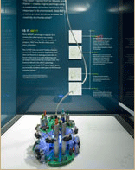The American Museum of Natural History in New York recently added a new piece to its holdings. RAP (Robotic Action Painter), devised by Leonel Moura, is now part of the permanent display at the Hall of Human Origins. As the wall text states, 'This robot [...] creates original paintings using a combination of random decisions and responses to its environment.' So, does RAP's process emulate human creativity? In a recent interview, Moura says that 'most people understand now what Artificial Intelligence is. They accept the fact that it is today possible to simulate intelligence in machines and robots. Hence I propose a similar concept for art. We can now build machines and robots able to create their own art.' RAP takes around 320 minutes to make a work. It starts by choosing a position on a large sheet of paper, selecting a color, and then drawing a scribbly line. When its sensors detect large enough patches of color, it enters an interactive mode, developing the existing sketch. The patches of color grow organically, becoming more and more dense. When it finds a single, densely painted area with uniform coloring, it decides that the work is finished. It then signs its initials in the bottom right corner of the painting. Although the same wall text asks if RAP is truly an artist, declaring that 'unlike a human, RAP has no inspiration,' one could think that RAP at least demonstrates that the artistic gesture is no longer confined to the human realm, further contributing to the eternal yet still pertinent question of what art is. - Miguel Amado
